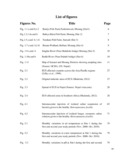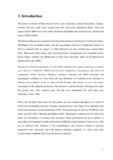Please use this identifier to cite or link to this item:
http://archive.nnl.gov.np:8080/handle/123456789/158| Title: | STUDIES ON SOME PHYSICO-CHEMICAL PARAMETERS OF WATER BODIES AND MICROBIAL FISH DISEASES IN EASTERN NEPAL |
| Authors: | Thapa, Ganesh Bahadur |
| Keywords: | Studies on some physico-chemical parameters of water bodies and microbial fish diseases in Eastern Nepal” |
| Issue Date: | 24-Mar-2019 |
| Abstract: | TThe present study entitled “Studies on some physico-chemical parameters of water bodies and microbial fish diseases in Eastern Nepal” consisting of the experiment has been presented in three broad sections. First section deals with physico-chemical parameters of water bodies for two years (November 2008-October 2010) emphasizing with disease prone area. Second section deals with isolation, characterization and identification of bacteria and third section includes histopathology of naturally EUS infected fishes, other commonly occurred microbial fish diseases and pathogenicity of isolated bacteria and fungus from EUS affected fishes. Different physico-chemical factors of water of six water bodies; four ponds [three artificial ponds Baidya Fish Farm, Tankisinwari, Morang (S1), Babiya Birta Fish Farm, Morang (S2) and Tarahara Fish Farm,Sunsari (S3) and one natural pond, Betana Wetland, Morang (S4)] and two rivers Singhia river, Morang (S5) and Budhi river, Duhabi, Sunsari (S6) of eastern Nepal were studied for two years. Temperature, pH, turbidity, DO, BOD, free CO2, Chloride (Cl-), TA and TH were determined following standard methods. Correlation, t-test, two ways ANOVA among sites and seasons, and standard deviation were calculated using SPSS-V20 and Microsoft excel statistical function of computer software respectively. Out of six water bodies EUS outbreaks were recorded in three fish farms S1, S2 and S3 from 2008-2015. Generally the outbreak of EUS takes place in the month of December and persists up to March. No outbreak of the disease was found in three water bodies S4, S5 and S6. Results showed that prior to the outbreak of the disease there were significant (p<0.01, p<0.05) declining trends of two factors e.g. total alkalinity and total hardness of water of the three fish farms and the factors remained low for few months. Declining trends of total alkalinity and total hardness were also noticed in other water bodies where no outbreak of disease was found. But, TA and TH values of corresponding months during first and second year were insignificantly different (P< 0.05) in all sites at 5% level of significance. ANOVA results of air temperature, water temperature and pH showed significant different at 1% level among seasons. CO2 was significantly different at 5% level among sites and DO at 1% level among seasons. TA viii was significantly different at 1% level among sites and seasons but TH was significantly different at 1% among sites and 5% levels among seasons. Cl- was significantly different at 1% among sites. High fluctuation of CO2 was due to the rotten vegetation especially in Site 4. Fall of surface water temperature was noticed in all water bodies studied during the one set of the disease. Water temperature remained below 30ºC most of the time of the year and only for a short period of time it goes above 30ºC. It appeared that this condition is favourable for the growth of bacteria and fungus. Altogether 444 naturally EUS affected fishes were collected and examined. The order of succeptibility was about 60% Cirrhinus mrigala, 30% Labeo bata / L. rohita, 7% Catla catla, 3% Channa striatus, Puntius sp., Heteropneustes fossilis, Mystus tengara, Clarias batrachus and Lepidocephalichthys guntea (rarely) among 444 affected fishes. Fungus (A1, A2, A3, and A4) were isolated from the ulcers of naturally infected Cirrhinus mrigala, Catla catla, Labeo bata and Puntius sp.. The isolated aseptate fungus was identified as Aphanomyces sp. by its characteristics sporangia which were not wider than the hyphae and the ball of sporangia at the tip of sporangium was developed. The single row of primary zoospores was found within the zoosporangia. The slender fungal hyphae were grown in fungal media but isolated fungus did not grow at 37ºC. Zoospores (A1) of isolated fungus Aphanomyces sp. were pathogenic to other fishes when inoculated in experimental fish H. fossilis. Histopathology of naturally and experimentally infected fish clearly showed the Aphanomyces sp. filaments from ulcer as a primary pathogen of EUS. When isolated bacteria and zoospores of Aphanomyces were inoculated separately into the experimental fish Heteropneustes fossilis, lesions were developed. So it is proved that the causative agent is Aphanomyces sp.. However, bacteria might have played the secondary role to develop the skin lesions. Other diseases prominently seen were bacterial fin rots; abdominal dropsy, gas bubble diseases and bacterial haemorrhagic septicemia. Bacteria were isolated from the ulcers of naturally infected Cirrhinus mrigala, Catla catla, Channa striatus, Puntius sp., Mystus tengara and Labeo bata. Among 23 isolates, 2 belong to Pseudomonas sp. from Lb1 and Cc4, 2 belong to Micrococcus sp. from Cm2 and P4, 14 bacteria were of Aeromonas hydrophila isolated from Cm1, Cm3, Cs1, P1, P3, Lb2, Lb3, Cc1, Cc2, Cc3, Mt1, ix Mt2, Mt3 and Mt4. 1 belongs to Moraxella sp. from P2, 1 belongs to Aeromonas veroni biovar sobria from Lb4 and 3 belong to Aeromonas caviae from Cm4, Cs2 and Cs3. All together 20 bacterial isolates were pathogenic and 3 were non- pathogenic (Table 5.42). Although lowering of water temperature, total alkalinity and total hardness was supposed to be helpful to outbreak microbial diseases including the EUS by weakening the immune system of fish, it does always not happen so and it is still unclear because in similar physico-chemical conditions, outbreak of the disease occurred in some areas (S1, S2 and S3) but not occurred in other areas (S4, S5 and S6). From the above discussion and results of the experiments (Figs.5.1,5.2,5.8,5.9 5.11-5.13,5.15, 5.21,5.22,5.24, 5.26, 5.28, 5.34, 5.35, 5.37- 5.39, 5.41,5.47,5.48, 5.50-5.52, 5.54, 5.61,5.62,5.64-5.66,5.68,5.75,5.76,5.78-5.80; Figs. 5.81a and b to 5.88a and b ; Tables 5.36 to 5.42), it can be concluded that both bacteria and fungus Aphanomyces sp. play important roles when temperature remains low in winter months in the appearance of EUS (Epizootic Ulcerative Syndrome) and it is the major fish disease but other fish diseases (abdominal dropsy, haemorrhagic septicaemia of carps, fin rot and gas bubble disease) are minor fish diseases in eastern Nepal. |
| URI: | http://103.69.125.248:8080/xmlui/handle/123456789/158 |
| Appears in Collections: | 300 Social sciences |
Files in This Item:
| File | Description | Size | Format | |
|---|---|---|---|---|
| Phd final thesis.docx | 249.12 kB | Microsoft Word XML | View/Open | |
| 9,Tables list final.pdf | 49.7 kB | Adobe PDF |  View/Open | |
| 10,List of Figures -final,.pdf | 168.74 kB | Adobe PDF |  View/Open | |
| Ph. D. Thesis of Ganesh B. Thapa.pdf | 9.85 MB | Adobe PDF |  View/Open | |
| 12, Thesis after correction.pdf | 8.14 MB | Adobe PDF |  View/Open |
Items in DSpace are protected by copyright, with all rights reserved, unless otherwise indicated.